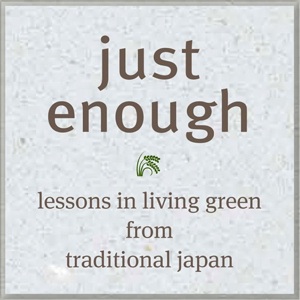Tom Baker (Chiba-ken, 1989-91) is a staff writer for The Daily Yomiuri. He usually writes for DYWeekend, the paper’s arts and leisure section. You can follow Tom’s blog at tokyotombaker.wordpress.com.
He recently interviewed Azby Brown, author of “Just Enough,” a book that describes how Japanese people 200 years ago (including the million-plus residents of Edo, which was the world’s largest city at the time) led environmentally sustainable lives. Here is an excerpt:
 Most of the details are of purely historical interest. It is unlikely, for instance, that you will ever need to stitch a thatched roof onto your house with a wooden sewing needle the size of a spear.
Most of the details are of purely historical interest. It is unlikely, for instance, that you will ever need to stitch a thatched roof onto your house with a wooden sewing needle the size of a spear.
However, the larger patterns that emerge from the details are of vital interest today. A farmer’s thatched roof could be made of rice straw, making good use of a by-product of food production. The same straw also was used to make rope, sandals, bags or mats. And when those items were worn out, they could be composted or mulched to help grow more rice, or they could be burned as fuel, incidentally creating ash that could be sold to the makers of ceramics, dyes and other products.
Brown calls this an example of “the zero-waste ideal.” But it wasn’t just farmers living close to the land who approached this ideal. Even urban Edo recycled almost everything and wasted almost nothing. “It was a self-policing system, because nearly every waste product had economic value for someone else,” Brown writes.
“Waste product” in this context means more than just rags, scraps and ash. Even the contents of the city’s toilets had economic value, with farmers paying for the privilege of hauling “night soil” away to make compost for their fields. Urine was collected separately, to extract ammonia and other useful chemicals.
Brown thinks these are practices to which the modern world would do well to return, especially in the present era of “alarming topsoil losses.” Unfortunately, the “yuck factor” keeps such resources from being utilized.
“I don’t know if you’ve ever seen…a composting toilet,” Brown said in the interview. “The compost that comes out is absolutely inoffensive. You really would think it was peat moss. You would not know what it was. There is almost no smell. [The problem is] the idea more than anything else.”
The use of night soil as farm fertilizer actually promoted public health in the Edo era, Brown writes. Because waste was collected and hauled away, it stayed out of the urban groundwater supply, helping to spare Edo from the deadly cholera epidemics that often swept large Western cities of the time.


one comment so far...
Just got this book as a gift — I’d definitely recommend it to anyone interested in the overlapping spheres of Japanese history and environmental sustainability/lifestyle design. The illustrations are a plus, too!